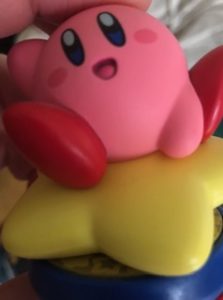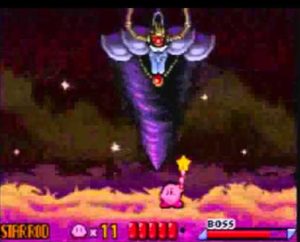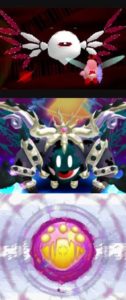Welcome to the cKotch.Com blog. I’m Christopher Kotcher, and this is Game Story. Time to discover lessons in writing found in gaming.

A Breakdown of Lore
In terms of storytelling, lore generally refers to the deeper story underlying a main plot. It’s an element of worldbuilding that helps set a story in a deeper history.
Videogames have come to offer some of the finest example of lore.
You see many gamers find story as something that merely gets in the way of jumping across platforms and shooting demons. Many other gamers desire a reason to play beyond getting to the goal in every level.
The vast canyon beyond these two camps has led many developers to try building bridges made of lore.
Sure, the story of a game may be simple. Then you start finding extra collectibles scattered around the levels. You gather these cartridges, memories, or artifacts and learn about the world you’ve been exploring.
Typically, this lore would be covered in a game’s pause screens and menus.
The Metroid Prime series has its logbooks, Super Mario Odyssey has its travel brochures, and Ratchet and Clank has radio stations for your spaceship and advertisements for your weapons and gadgets.
Essentially, those who desire no story can play with minimal interruption. Those who want a deeper purpose to their quests can find it.
Examining these examples can help all kinds of storytellers. You learn how to plant little details which give your tales extra purpose to those who seek it.
Perhaps an example is in order. I’m going to cover one of the best examples of lore in the whole medium of gaming. It’s a revered series which strikes a near-perfect balance between grand world building and simple plots.
Let’s talk about Nintendo’s very own star warrior, Kirby.

The Unsuspecting Puffball
Any fan of Nintendo knows Kirby, the gluttonous pink puffball with a friendly smile created by the same mind behind the fighting crossover game Super Smash Bros.
Kirby lives in the Kingdom of Dreamland and the star-shaped Planet Popstar. He swallows his enemies with his vacuum-like breath. Sometimes, he can copy their powers too.
On the surface, this series doesn’t seem anything to different from other simpler Nintendo series.
Mario rescues Princess Peach from Bowser. Donkey Kong recovers his bananas from whatever new thief of the week. Kirby saves dreamland from his penguin rival King Dedede.
I thought the same until I grabbed a little game called Kirby: Nightmare in Dreamland for the GameBoy Advance, a remake of the classic NES game Kirby’s Adventure.
Here, King Dedede has broken the magical Star Rod into seven fragments and scattered them across Dreamland. Without this crucial relic, the waters of the sacred Fountain of Dreams are unable to flow, and the residents of Popstar can no longer dream.
Naturally, Kirby travels the land and repairs the Star Rod. He confronts King Dedede and goes to restore the Fountain of Dreams.
Then King Dedede starts throwing himself at Kirby’s feet. The proud penguin is groveling, begging his rival not to return the fountain to its former glory.
Something starts to feel off.
Kirby returns the Star Rod to the Fountain, and the skies darken. Lightning rages all around. A sphere covered in stars rises from the fountain, and the storms in the distance grow increasingly chaotic.
Apparently, Dedede had separated the rod from the fountain because an ancient evil had infected it. The dread wizard Nightmare sought to steal the power of the sacred site and conquer Dreamland.
In one last act of desperation, Dedede flings Kirby into the sky with the Star Rod in hand. The hero uses the relic’s power to destroy Nightmare and truly restore the fountain.
That final battle really was something to me. This wasn’t just fighting Bowser over another bridge of lava.
After breaking Nightmare’s sphere, the true villain emerged in all his might. His body was made of tornados, and he could send forth lightning with a mere snap of his fingers.

Seeing his body fade into the stormy sky upon his defeat was one of my most satisfying achievements as a young gamer.
This kind of twist got me thinking about Dreamland and Popstar far more deeply than the Mushroom Kingdom or DK Island.
Where did Nightmare come from? How was he powerful enough to contaminate the Fountain of Dreams? How did King Dedede know the fountain was even being corrupted?
I wanted to see what other mysteries Kirby’s world held. This desire led me to play any game I could and research any game I couldn’t.
Taste-Testing the Series

Kirby already had quite the history when I started following the series.
The series’ next major villain after Nightmare’s defeat would be the all-consuming Dark Matter. This blobby foe sought to devour and control everything in the world.
The Super Nintendo games Kirby’s Dreamland 2 and Kirby’s Dreamland 3 saw the hero’s first fights with Dark Matter.
Battles with a possessed King Dedede and mysterious blobby swordsman led to confronting Dark Matter’s ultimate source, the floating eyeball monster Zero.
After Zero’s defeat, Kirby would go on to repair a magic crystal on the fairy world of Ripplestar in Kirby 64: The Crystal Shards.
Surprise! The crystal was shattered by a new source of Dark Matter, the twisted fallen angel monster 02. Apparently, the rising villain feared the crystal’s power to purify anyone it possessed.
For the longest time, Dark Matter kept finding new ways to return. A new source would always arise.
When games came out with little apparent connection to Dark Matter, fans always raced to make theories and connections.
In the Wii modern classic Kirby’s Return to Dreamland, the hero faced a foe who had stolen a devastating ancient weapon known as the Master Crown.
When the villain was defeated, the crown refused to lose. It consumed its master’s soul and became a monster. The vapory form, covered in chains and tattered clothes, featuring an eye in its mouth, reminded many of Dark Matter.
Speculation ran rampant.
Was this form a mere accident? Did the Master Crown connect in some way to Dark Matter? Was it possibly just basing its final form on Kirby’s memories?
Even the series’ spinoff games provide similar implications.
Kirby’s first Nintendo DS game, Kirby’s Canvas Curse, was all about using the system’s touchscreen to guide a Kirby ball through stages.
The story here focused on an evil witch named Drawcia. She transformed Dreamland into a painting and turned Kirby into a ball to weaken him.
At this adventure’s end, Drawcia clung to life by becoming the vicious paint monster Drawcia Soul. It was another creature not too different from Zero and Dark Matter.
Soon enough, other art witches appear. Drawcia’s sister Paintra becomes an early boss in Kirby: Triple Deluxe. The mysterious Claycia is central to the plot of Kirby and the Rainbow Curse.
At a basic level, these various references tease and reward long-term fans. They may also push newer fans to investigate the older games.
Gradually, the lore builds up between the games to create a good sense of how Kirby’s world works. Players are invited to craft a grander story in their own minds.
Kirby is a model for balancing deeper underlying stories with simple, approachable plots welcoming to newcomers and casual fans.
Thing is, this doesn’t even touch on the crown jewel of Kirby lore yet.
The Starry Epilogue
At time of writing, Kirby: Star Allies is the pink puffball’s latest adventure. This tale is one of the series’ simplest, but its lore implications of some of the games’ grandest.
On a distant world, a robed figure known as Hyness performs a foul ritual on a crystal heart. His efforts cause the crystals pinned into the heart to scatter as smaller hearts across the cosmos.
Two of these hearts descend to Popstar. One touches Kirby, granting him the power to befriend enemies. The other corrupts anything it touches.
Kirby chases the corrupting heart across Popstar, gathering a little army of classic friends and foes from throughout his many adventures. This chase leads Kirby to discover Hyness’ intentions and pursue his forces into space.
Eventually reaching the citadel, Kirby meets Hyness. The demented figure goes off on an insane rant.
Hyness claims heritage from an ancient race of magicians. They were rivals to an ancient race of scientists which devised much of the technology in Kirby’s universe, including the Master Crown.
Now Hyness seeks to revive the Dark Lord which ruled his people in the distant past. He wants to destroy everything his kind’s eternal rivals have created and anything they have even remotely touched.
Kirby’s greatest foe son awakens, the unbelievable abomination, Void Termina. The battle rages both across space and inside the beast’s own body.
Here is where all those Dark Matter connections become more than theories.
Void Termina’s chaotic soul takes many forms in its battle with Kirby. It starts as a formless sphere before becoming some kind of proto-Dark Matter. Finally, its face grows to resemble none other than Kirby himself.
Beyond the game’s story modes, harder versions of Void Termina can appear. Its soul constantly struggles between its Dark Matter and Kirby appearances.
The Void Soul’s final defeat always comes in its Kirby form. It smiles as it explodes. If the game is paused during this fight, a description for the boss states it wishes to be born as something new. It can even be made something positive or negative depending on the one who defeats it.

Now that’s the kind of final battle which leaves you with a few questions.
Turns out we shouldn’t have been asking if every villain is like Dark Matter. We should’ve been wondering how similar Dark Matter and Kirby are. After all, they are both known for consuming things and taking their power.
Discussion Time!
Many larger Kirby fans than I have racked their brains with the many questions presented in the series’ lore. I do not pretend to have any of the answers, especially when standing next to them.
Still, what do you think of this examination into the deep lore of a simple series? Do you think myself and all the other Kirby fans are reaching, or do we really have something here?
Does this post help you understand what lore can accomplish in even the simplest of stories? Do you see how this tool builds a story’s grander world?
Kotcher’s Call to Action
If you like my content and wish to see more, you could check out my books Five Strange Stories and Good Stuff: 50 Poems from Youth on Amazon. They are enrolled in the Kindle Matchbook program, so anyone who buys the paperbacks can also get the eBooks for free.
Finally, be sure to like my Facebook page and share it with your friends. I post a link there whenever a new blog post goes live each Friday at 5:00 PM EST.